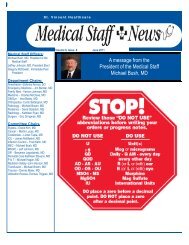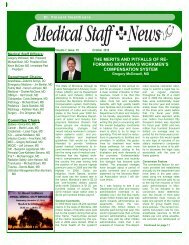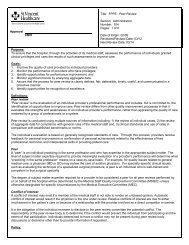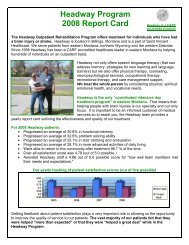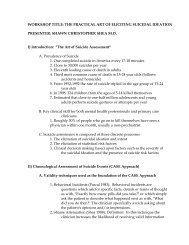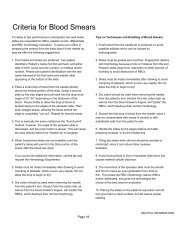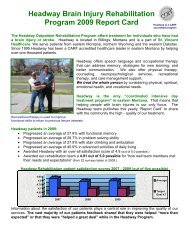AHA/ASA Guideline Guidelines for the Prevention of Stroke in ...
AHA/ASA Guideline Guidelines for the Prevention of Stroke in ...
AHA/ASA Guideline Guidelines for the Prevention of Stroke in ...
You also want an ePaper? Increase the reach of your titles
YUMPU automatically turns print PDFs into web optimized ePapers that Google loves.
246 <strong>Stroke</strong> January 2011bleed<strong>in</strong>g, <strong>in</strong>clud<strong>in</strong>g cerebral hemorrhage, did not reach statisticalsignificance.Biopros<strong>the</strong>tic valves are associated with a lower rate <strong>of</strong>thromboembolism than mechanical valves. In patients withbiopros<strong>the</strong>tic valves who have an o<strong>the</strong>rwise unexpla<strong>in</strong>edischemic stroke or TIA, oral anticoagulation (INR 2.0 to 3.0)is suggested.Recommendations1. For patients with ischemic stroke or TIA who havemechanical pros<strong>the</strong>tic heart valves, warfar<strong>in</strong> is recommendedwith an INR target <strong>of</strong> 3.0 (range, 2.5 to3.5) (Class I; Level <strong>of</strong> Evidence B).2. For patients with mechanical pros<strong>the</strong>tic heart valveswho have an ischemic stroke or systemic embolismdespite adequate <strong>the</strong>rapy with oral anticoagulants,aspir<strong>in</strong> 75 mg/d to 100 mg/d <strong>in</strong> addition to oralanticoagulants and ma<strong>in</strong>tenance <strong>of</strong> <strong>the</strong> INR at atarget <strong>of</strong> 3.0 (range, 2.5 to 3.5) is reasonable if <strong>the</strong>patient is not at high bleed<strong>in</strong>g risk (eg, history <strong>of</strong>hemorrhage, varices, or o<strong>the</strong>r known vascularanomalies convey<strong>in</strong>g <strong>in</strong>creased risk <strong>of</strong> hemorrhage,coagulopathy) (Class IIa; Level <strong>of</strong> Evidence B).3. For patients with ischemic stroke or TIA who havebiopros<strong>the</strong>tic heart valves with no o<strong>the</strong>r source <strong>of</strong>thromboembolism, anticoagulation with warfar<strong>in</strong>(INR 2.0 to 3.0) may be considered (Class IIb; Level<strong>of</strong> Evidence C) (Table 8).IV. Antithrombotic Therapy <strong>for</strong>Noncardioembolic <strong>Stroke</strong> or TIA (Specifically,A<strong>the</strong>rosclerotic, Lacunar, orCryptogenic Infarcts)A. Antiplatelet AgentsFour antiplatelet drugs have been approved by <strong>the</strong> FDA <strong>for</strong>prevention <strong>of</strong> vascular events among patients with a stroke orTIA: aspir<strong>in</strong>, comb<strong>in</strong>ation aspir<strong>in</strong>/dipyridamole, clopidogrel,and ticlopid<strong>in</strong>e. On average, <strong>the</strong>se agents reduce <strong>the</strong> relativerisk <strong>of</strong> stroke, MI, or death by about 22%, 291 but importantdifferences exist between agents that have direct implications<strong>for</strong> <strong>the</strong>rapeutic selection.Aspir<strong>in</strong>Aspir<strong>in</strong> prevents stroke among patients with a recent stroke orTIA. 233,292–294 In a meta-regression analysis <strong>of</strong> placebocontrolledtrials <strong>of</strong> aspir<strong>in</strong> <strong>the</strong>rapy <strong>for</strong> secondary strokeprevention, <strong>the</strong> relative risk reduction <strong>for</strong> any type <strong>of</strong> stroke(hemorrhagic or ischemic) was estimated at 15% (95% CI,6% to 23%). 295 The magnitude <strong>of</strong> <strong>the</strong> benefit is similar <strong>for</strong>doses rang<strong>in</strong>g from 50 mg to 1500 mg, 233,291,292,294–296 although<strong>the</strong> data <strong>for</strong> doses 75 mg are limited. 291 In contrast,toxicity does vary by dose; <strong>the</strong> pr<strong>in</strong>cipal toxicity <strong>of</strong> aspir<strong>in</strong> isgastro<strong>in</strong>test<strong>in</strong>al hemorrhage, and higher doses <strong>of</strong> aspir<strong>in</strong> areassociated with greater risk. 292,294 For patients who uselow-dose aspir<strong>in</strong> (325 mg) <strong>for</strong> prolonged <strong>in</strong>tervals, <strong>the</strong>annual risk <strong>of</strong> serious gastro<strong>in</strong>test<strong>in</strong>al hemorrhage is about0.4%, which is 2.5 times <strong>the</strong> risk <strong>for</strong> nonusers. 292,294,297,298Aspir<strong>in</strong> <strong>the</strong>rapy is associated with an <strong>in</strong>creased risk <strong>of</strong>hemorrhagic stroke that is smaller than <strong>the</strong> risk <strong>for</strong> ischemicstroke, result<strong>in</strong>g <strong>in</strong> a net benefit. 299Ticlopid<strong>in</strong>eTiclopid<strong>in</strong>e is a platelet adenos<strong>in</strong>e diphosphate (ADP) receptorantagonist that has been evaluated <strong>in</strong> 3 randomized trials<strong>of</strong> patients with cerebrovascular disease. 300–302 The CanadianAmerican Ticlopid<strong>in</strong>e Study (CATS) compared ticlopid<strong>in</strong>e(250 mg twice a day) with placebo <strong>for</strong> prevention <strong>of</strong> stroke,MI, or vascular death <strong>in</strong> 1053 patients with ischemicstroke. 302 After a mean follow-up duration <strong>of</strong> 2 years, patientsassigned to ticlopid<strong>in</strong>e <strong>the</strong>rapy had fewer outcomes per year(11.3% compared with 14.8%; relative risk reduction [RRR],23%; 95% CI, 1% to 41%). The Ticlopid<strong>in</strong>e Aspir<strong>in</strong> <strong>Stroke</strong>Study (TASS) compared ticlopid<strong>in</strong>e 250 mg twice a day withaspir<strong>in</strong> 650 mg twice a day <strong>in</strong> 3069 patients with recent m<strong>in</strong>orstroke or TIA. 301 After 3 years, patients assigned to ticlopid<strong>in</strong>ehad a lower rate <strong>for</strong> <strong>the</strong> primary outcome <strong>of</strong> stroke ordeath (17% compared with 19%; RRR, 12%; 95% CI, 2% to26%; P0.048 by Kaplan-Meier estimates). F<strong>in</strong>ally, <strong>the</strong>African American Antiplatelet <strong>Stroke</strong> <strong>Prevention</strong> Study enrolled1809 black patients with recent noncardioembolicischemic stroke who were allocated to receive ticlopid<strong>in</strong>e 250mg twice a day or aspir<strong>in</strong> 325 mg twice a day. 300 The studyfound no difference <strong>in</strong> risk <strong>of</strong> <strong>the</strong> comb<strong>in</strong>ation <strong>of</strong> stroke, MI,or vascular death at 2 years. Side effects <strong>of</strong> ticlopid<strong>in</strong>e <strong>in</strong>cludediarrhea and rash. Rates <strong>of</strong> gastro<strong>in</strong>test<strong>in</strong>al bleed<strong>in</strong>g arecomparable or less than with aspir<strong>in</strong>. Neutropenia occurred <strong>in</strong>2% <strong>of</strong> patients treated with ticlopid<strong>in</strong>e <strong>in</strong> CATS and TASS;however, it was severe <strong>in</strong> about 1% and was almost alwaysreversible with discont<strong>in</strong>uation. Thrombotic thrombocytopenicpurpura has also been described. 303ClopidogrelAno<strong>the</strong>r platelet ADP receptor antagonist, clopidogrel, becameavailable after aspir<strong>in</strong>, comb<strong>in</strong>ation aspir<strong>in</strong>/dipyridamole,and ticlopid<strong>in</strong>e were each shown to be effective <strong>for</strong>secondary stroke prevention. As a s<strong>in</strong>gle agent, clopidogrelhas been tested <strong>for</strong> secondary stroke prevention <strong>in</strong> 2 trials,one compar<strong>in</strong>g it with aspir<strong>in</strong> 298 alone and one compar<strong>in</strong>g itwith comb<strong>in</strong>ation aspir<strong>in</strong>/dipyridamole. 304 In each trial, rates<strong>of</strong> primary outcomes were similar between <strong>the</strong> treatmentgroups. Clopidogrel has not been compared with placebo <strong>for</strong>secondary stroke prevention. 305Clopidogrel was compared with aspir<strong>in</strong> alone <strong>in</strong> <strong>the</strong> Clopidogrelversus Aspir<strong>in</strong> <strong>in</strong> Patients at Risk <strong>of</strong> Ischemic Events(CAPRIE) trial. 298 More than 19 000 patients with stroke, MI,or peripheral vascular disease were randomly assigned toaspir<strong>in</strong> 325 mg/d or clopidogrel 75 mg/d. The annual rate <strong>of</strong>ischemic stroke, MI, or vascular death was 5.32% amongpatients assigned to clopidogrel compared with 5.83% amongpatients assigned to aspir<strong>in</strong> (RRR, 8.7%; 95% CI, 0.3 to 16.5;P0.043). Notably, <strong>in</strong> a subgroup analysis <strong>of</strong> patients whoentered CAPRIE after a stroke, <strong>the</strong> effect <strong>of</strong> clopidogrel wassmaller and did not reach statistical significance. In thissubgroup <strong>the</strong> annual rate <strong>of</strong> stroke, MI, or vascular death was7.15% <strong>in</strong> <strong>the</strong> clopidogrel group compared with 7.71% <strong>in</strong> <strong>the</strong>aspir<strong>in</strong> group (RRR, 7.3%; 95% CI, 6% to 19%; P0.26).CAPRIE was not designed to determ<strong>in</strong>e if clopidogrel wasequivalent to aspir<strong>in</strong> among stroke patients.Clopidogrel was compared with comb<strong>in</strong>ation aspir<strong>in</strong> andextended-release dipyridamole <strong>in</strong> <strong>the</strong> PRoFESS trial, whichDownloaded from stroke.ahajournals.org by on March 8, 2011



